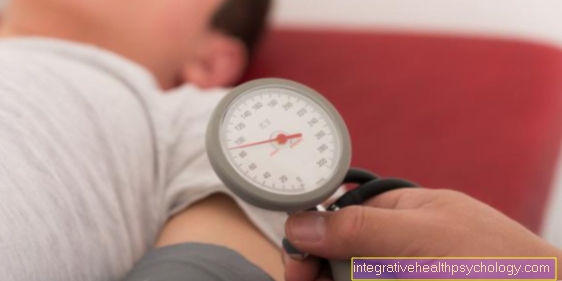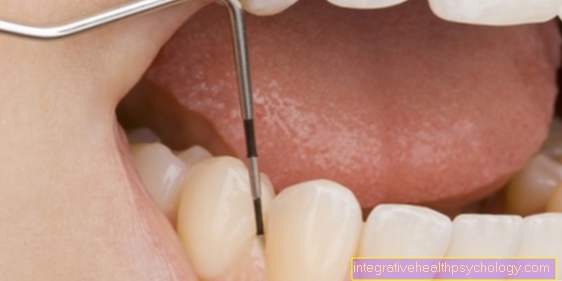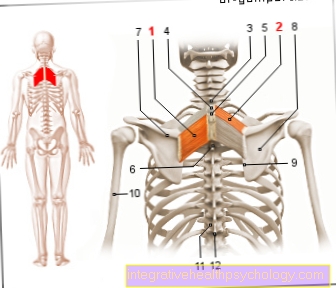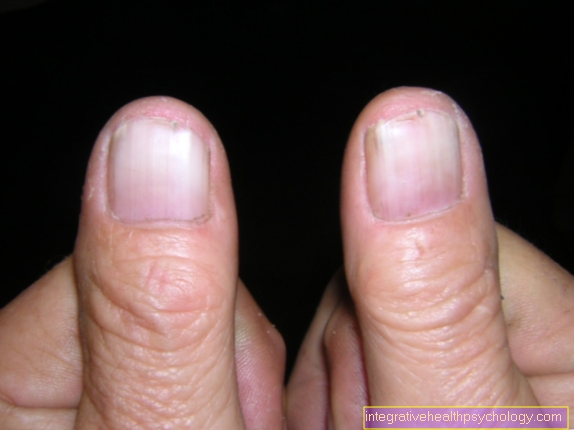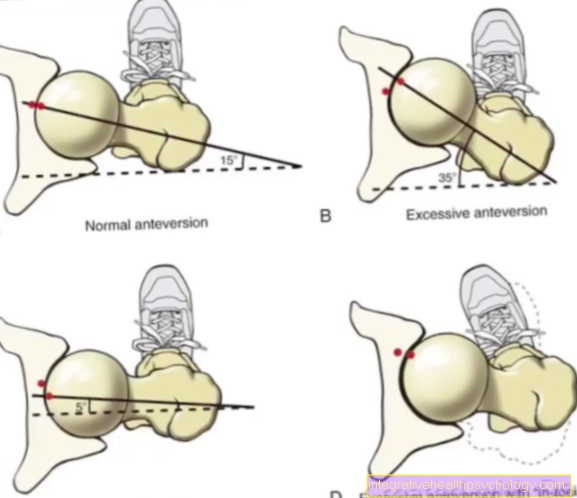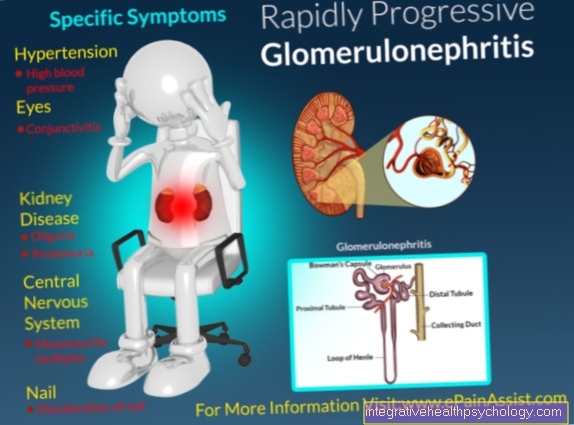Fluoxetine
Fluoxetine is a drug that is mainly used to treat depression. It belongs to the group of selective serotonin reuptake inhibitors (SSRIs). Compared to the tricyclic antidepressants (amitriptyline, clomipramine, nortriptyline) prescribed for years in depression therapy, fluoxetine is significantly better tolerated and a smaller spectrum of side effects. It can also be used in children and adolescents aged 8 years and over to treat moderate and severe episodes of depression. In Germany, the active ingredient is only available with a prescription in pharmacies.

Indications
Typically, fluoxetine is used in adults as part of the Treatment of Depressive Disorders used. Especially in very severe depressive episodes (major depression), the selective serotonin reuptake inhibitors (SSRIs) means of choice. Patients under very strong depressions suffer, are listless, dejected and depressed. Often there are accompanying weight changes due to a changed appetite and sleep disorders. At the same time, thinking is greatly slowed down and patients have difficulty concentrating.
In addition, fluoxetine can also be used for Treatment of obsessive-compulsive disorder and bulimia be prescribed. Obsessive-compulsive disorder is a content-based thought disorder in which a patient feels an internal compulsion to think or do certain things. Bulimia (also called eating-vomiting addiction) is a typical, psychological eating disorder. Patients suffer from repeated attacks of food cravings with subsequent great fear of weight gain. This is why these patients usually vomit up the food they have previously consumed straight away. Fluoxetine can be prescribed to accompany psychotherapy in order to continuously reduce binge eating and vomiting.
Fluoxetine can be used in children and adolescents aged 8 years and over Treatment of moderate and severe episodes of depression be applied. This drug treatment should be supported by accompanying psychotherapeutic therapy. It should be noted, however, that minors have a significantly higher risk of side effects (including thoughts of attempting suicide and increased hostility).
fear
Many patients with depression or obsessive-compulsive disorder also have severe, recurring anxiety attacks. To treat this, the Selective Serotonin Reuptake Inhibitors (SSRIs) are a good alternative to the typically prescribed benzodiazepines on.
The SSRIs (including fluoxetine) have one Anxiety and tension relieving effect and thus work against both the depression and the accompanying anxiety attacks. This effect is due to the increase in serotonin levels in the central nervous system. B.already after a few weeks there is a brightening of mood with a reduction in anxiety attacks.
Compared to the classically prescribed benzodiazepines, fluoxetine is more effective not the risk of developing addiction. While benzodiazepines should not be taken continuously for longer than 4 to 6 weeks for this reason, long-term medication with fluoxetine can be continued for several months.
Active ingredient and effect
The active ingredient fluoxetine acts as a selective serotonin reuptake inhibitor (SSRI) at the synapses between two nerve cells in the central nervous system. To transmit signals, a nerve cell releases various neurotransmitters into the synaptic gap, which bind to receptors in another nerve cell and transmit the signal. The remaining neurotransmitters are then broken down and taken up again into the nerve cells via the transporters. Fluoxetine blocks these serotonin transporters and selectively inhibits the reuptake of serotonin. Due to the increased serotonin level in the synaptic gap, the signal transmission between two nerve cells is lengthened and reinforced.
The exact cause and development of depression is not yet fully understood. However, a deficiency in the neurotransmitters serotonin and noradrenaline seems to be a major contributor to the development of depression. By a Increasing the serotonin level in the central nervous system during treatment with fluoxetine therefore has an anxiety-reducing, mood-enhancing and drive-enhancing effect.
Onset of action
When treating with fluoxetine, it should be borne in mind that a Anxiety-reducing and mood-enhancing effect at the earliest after 1 to 2 weeks occurs. Depending on the patient, the anxiety attacks may even intensify slightly within this period.
Instead, the drive-increasing and activating effect on the patient in a timely manner after taking the drug. For this reason, warnings are given of an increased risk of suicide during the first few weeks after the start of therapy. Children, adolescents and young adults are particularly at risk. The start of the therapy should therefore be checked regularly by a doctor, especially during this period.
What to do if the effect wears off
In the course of therapy with fluoxetine, the effect may decrease depending on the patient. The body develops a kind of slight tolerance to the drug and gets used to the permanently elevated serotonin levels.
In consultation with a doctor, a higher dosage counteract the diminishing effect. The maximum daily dose can be increased up to 60 mg. You should, however individually adapted and can only be increased slowly. A changed dosage must always be discussed with a doctor.
In addition, the preparation can be changed and a other antidepressant be prescribed. The five preparations of selective serotonin reuptake inhibitors currently on the market (SSRIs) can strike and work differently depending on the patient. In this case, too, a change should only be carried out in consultation with the treating doctor.
Side effects
Fluoxetine is characterized by a wide range of possible side effects. Compared to the tricyclic antidepressants that have been prescribed for years, however, fluoxetine is better tolerated and (severe) side effects occur significantly less frequently.
The majority of side effects during treatment with fluoxetine are rare (1 to 10 patients in 10,000). They occur mostly at the beginning of therapy and subside over time. They should therefore not be a reason for prematurely discontinuing therapy. Nausea and vomiting are very common during treatment with fluoxetine. Often times these symptoms are accompanied by insomnia, fatigue, loss of appetite, anxiety, and nervousness. In addition, sexual dysfunction with a loss of sexual desire (libido) can occur. Effects on weight are also possible. However, while some patients may gain weight, slight weight loss is also possible.
Serotonin Syndrome
Serotonin syndrome is a dreaded side effect of fluoxetine treatment. It occurs when the dose is increased rapidly or when the dose is overdosed due to the greatly increased serotonin level. Often it also arises from the combination of several drugs that have an influence on the serotonin level. Typical symptoms are dizziness and impaired consciousness. Involuntary twitching of the muscles, anxiety and a general feeling of illness are also frequently reported.
You can find further information under our topic: Serotonin Syndrome
fatigue
Symptoms of tiredness may occur more frequently, especially when starting fluoxetine therapy. The severity of the symptoms varies from patient to patient and can also depend on the dosage. Patients often complain of a strong lack of drive during the day and feel it often the need for an afternoon nap. In rare cases, there may be a slight clouding of consciousness and impairment of concentration and thinking. These symptoms usually progressively decrease over the course of treatment, because the drug unfolds its drive-enhancing effect after a few days to weeks.
If you are very tired and your consciousness is clouded, you can talk to your doctor about stopping the medication. If necessary, a reduction in the dose can also alleviate the symptoms. Since the various selective serotonin reuptake inhibitors (SSRIs) have very different effects from patient to patient, a switch to another preparation may also be indicated.
Side effects on the intestines
Treatment with fluoxetine also frequently results in side effects in the gastrointestinal tract. This is because serotonin is an important messenger substance in the nervous system of the intestine (enteric nervous system). The function of this system can be disrupted by the administration of fluoxetine. The symptoms also occur primarily at the beginning of treatment and gradually decrease after several weeks.
Patients often over complain Nausea and vomiting. An accompanying one follows from this Loss of appetite, which in high-dose therapy lead to a Weight loss can lead. Kick at the same time diarrhea and Indigestion heaped on.
libido
Another side effect that can occur with fluoxetine treatment is loss of libido (sexual desire).Men are particularly affected. The origin of this sexual dysfunction is not yet fully understood. Even taking the drug for a period of a few days can lead to the onset of symptoms.
Often patients report a decreased or non-existent libido. In addition, it is difficult to produce or maintain an erection or sexual arousal. A permanent erection or premature orgasms are also possible. In rare cases, patients report impotence.
After stopping the medication, the side effects can in some cases last for months to years. In very rare cases permanent sexual dysfunction has also been reported.
Liver side effects
After taking fluoxetine tablets, the active substance is metabolized in the liver by specific enzymes. At the same time, fluoxetine is broken down by liver enzymes. The heavy load on the liver can damage the liver tissue. Often there is a change in liver values (GOT, GPT) during therapy with fluoxetine. For this reason, liver function should be checked regularly and the dose adjusted accordingly if the liver is impaired.
Sleep disorder
While many patients complain of daily tiredness during treatment with fluoxetine, conversely, sleep disorders can also occur at night. As studies have shown, this effect is due to an influence on melatonin synthesis (sleep hormone) in the central nervous system. Compared to the tricyclic antidepressants, which have a depressant and thus sleep-promoting effect, the selective serotonin reuptake inhibitors (SSRIs) have a drive-increasing effect out. Patients often report severe fatigue, but cannot sleep long. Be at the same time these short sleep episodes are often accompanied by nightmares.
itching
Another common side effect are Sensory disturbances (Paresthesia) in the skin area with severe itching. This itching can vary in severity depending on the patient. He is often from Rashes on the skin with the formation of small blisters accompanied. If the symptoms are unclear or persistent, a doctor should always be consulted and the next steps should be discussed. If necessary, a Intolerance (allergy) against fluoxetine or other ingredients of the preparation.
Weight
Many of the antidepressants prescribed today have an impact on patients' weight. Gaining weight often has a negative effect on the success of treatment for depression. While the tricyclic antidepressants (Amitriptyline, Clomipramine, nortriptyline) and Mirtazapine lead to weight gain via an increase in appetite, fluoxetine therapy can also lead to weight gain Decrease in weight occur.
Some patients report about one Weight loss of several kilograms a month. This is mainly due to a decreased appetite in high-dose therapy. At the same time, you can also have a Dry mouth and a increasing change in taste occur as side effects, increasing the loss of appetite.
interaction
After taking fluoxetine in the form of tablets, the active substance is metabolized or activated in the liver by specific enzymes. After its effect in the central nervous system, it is only broken down in the liver after several days. The degradation takes place through enzymes, which are also required by other drugs. Because of this, you can Interactions with numerous other preparations (e.g. Carbamazepine, tricyclic antidepressants, e.g. Amitriptyline, Flecainide) occur. An adjustment of the medication dosage may therefore be necessary and should be discussed with the doctor.
A Use of other preparations that are effective in the central nervous system should always be discussed with the attending physician. There is a risk that a combination will influence the serotonin system so much that the occurrence of a Serotonin Syndrome (see side effects) is possible. Of this form of interaction with fluoxetine are mainly MAOIs (e.g. moclobemide), Johannis herbs, Linezolid, Tramadol, Triptans (e.g. Almotriptan or Naratriptan), lithium and tryptophan affected. Due to the long retention time of fluoxetine in the body (4 to 16 days), you should wait at least five weeks after stopping it before starting therapy with another drug.
At the same time, when combined with Anticoagulants (Blood thinners) increased frequency of abnormal bleeding has been observed.
dosage
The dosage of fluoxetine differs depending on the clinical picture and can be increased increasingly in the course of therapy. Fluoxetine is usually in the form of Tablets prescribed. A It can be taken with or between meals (with and without a glass of water). In the case of high-dose therapy, the total daily dose can also be divided and swallowed in several portions a day.
Fluoxetine therapy usually starts at 20 mg per day. This does not apply to the accompanying drug treatment of bulimia, where a daily dose of 60 mg is started immediately. For children and adolescents from 8 years of age, fluoxetine should be prescribed in the lowest possible dose and, if necessary, adjusted to the body weight.
In patients with impaired kidney and / or liver function, the dosage of the active substance must be adjusted accordingly.
10, 20, 40 mg for which applications?
For the treatment of depressive illnesses Therapy with fluoxetine is usually a Daily dose started from 20 mg. If the product is not effective or has limited effectiveness, the dose can be increased slowly up to 60 mg. The effectiveness of treatment with a daily dose of 80 mg per day has not yet been sufficiently investigated and is therefore not indicated. Drug treatment of depression with fluoxetine should be continued for at least 6 months.
The Therapy of obsessive-compulsive disorder with fluoxetine is comparable to that of depressive illnesses. It also comes with a Daily dose started from 20 mg. The dose can increasingly increased up to 60 mg become.
To Therapy for bulimia (Mental Eating Disorder) is right at the start of therapy started with a daily dose of 60 mg.
price
The various fluoxetine preparations are available in different pack sizes (20, 50, 100 tablets) and doses (10, 20, 40 mg). Individual tablets can also be halved. Fluoxetine is available from pharmacies on a prescription.
A A pack of 20 with 10 mg fluoxetine is available from a price of around 12.50 euros. The A pack of 20 with a higher dose of fluoxetine (20 mg) is available for around 14.00 euros to acquire. For a price of approx A pack of 20 containing 40 mg fluoxetine is available for 16.00 euros.
Fluoxetine and alcohol
While taking fluoxetine alcohol consumption should be avoided. After fluoxetine is ingested, it is metabolized in the liver. Both activation and degradation are carried out by liver enzymes. This will make the Function of the liver is heavily burdened. Since alcohol is also metabolized via the liver, considerable interactions can occur. Both the effects of alcohol and fluoxetine can be massively influenced. The Side effects of fluoxetine accumulate and increase in strength. Therefore, depending on the dosage of fluoxetine and alcohol sometimes life-threatening side effects occur. Typical side effects when consuming alcohol (dizziness, nausea, unsteadiness of movement) can possibly increase to such an extent that an unconsciousness up to coma is possible.
Overdose
In the event of an overdose of Fluoxetine, the above occur Side effects increased on. Compared to other antidepressants (including tricyclic antidepressants) are However, life-threatening side effects are only to be feared at very high doses (50 to 100 times higher dosage). By combining fluoxetine with other centrally acting preparations, even a slight overdose can lead to life-threatening effects.
In addition to permanent Nausea and vomiting such as severe diarrhea are persistent seizures possible. Also Heart trouble (such as an irregular heartbeat and heart rhythm disorders) and a Disturbance of the lung function (possibly with breathing difficulties) can occur. In addition, it comes to psychogenic changes (for example strong states of excitement, impaired consciousness, coma).
In the event of an overdose of fluoxetine should a doctor as soon as possible or the emergency department to the nearest clinic.
Drop
In a therapy with fluoxetine it comes in contrast to many other centrally acting substances does not lead to the development of psychological and physical dependence. Nevertheless, abrupt discontinuation of fluoxetine therapy leads to typical symptoms (withdrawal reaction) in many patients. Often occur in the first few days after discontinuing the drug Dizziness, Sensory and sleep disorders on. Also nausea, Vomit, a headache and Anxiety are possible. As a rule, however, these symptoms are only mild to moderate and subside spontaneously within a few weeks. In rare cases, however, the symptoms can persist for several months.
To avoid this settling reaction, one should Gradual withdrawal over a period of several weeks or months be respected. The daily dose should be continuously reduced and the course monitored by the attending physician.
Additional informationFurther interesting information about fluoxetine can be found at:
- Antidepressant effect
- SSRI
- Antidepressants and alcohol - are they compatible?
- Amitriptyline
- Antidepressant medication
Exclusion of liability / disclaimer
We would like to point out that medication must never be discontinued, applied or changed independently without consulting your doctor.
Please note that we cannot claim that our texts are complete or correct. The information may be out of date due to current developments.

